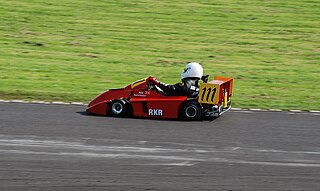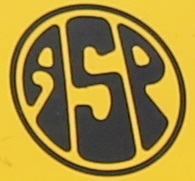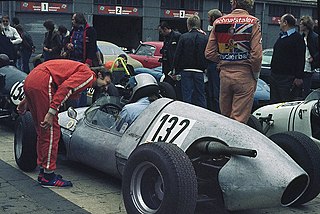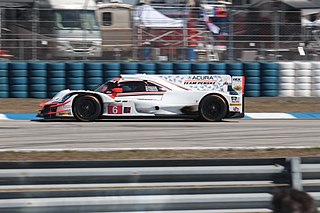Related Research Articles

An open-wheel car is a car with the wheels outside the car's main body, and usually having only one seat. Open-wheel cars contrast with street cars, sports cars, stock cars, and touring cars, which have their wheels below the body or inside fenders. Open-wheel cars are built both for road racing and oval track racing. Street-legal open-wheel cars, such as the Ariel Atom, are scarce as they are often impractical for everyday use.

Sports car racing is a form of motorsport road racing which utilises sports cars that have two seats and enclosed wheels. They may be purpose-built prototypes or grand tourers based on road-going models. Broadly speaking, sports car racing is one of the main types of circuit auto racing, alongside open-wheel single-seater racing, touring car racing and stock car racing. Sports car races are often, though not always, endurance races that are run over relatively large distances, and there is usually a larger emphasis placed on the reliability and efficiency of the car as opposed to outright speed of the driver. The FIA World Endurance Championship is an example of a sports car racing series.

The Lotus Seven is a small, simple, lightweight, two-seater, open-top, open-wheel, sports car produced by the British manufacturer Lotus Cars between 1957 and 1972.

Formula Two, abbreviated to F2, also called Formula 2, is a type of open-wheel formula racing category first codified in 1948. It was replaced in 1985 by Formula 3000, but revived by the FIA from 2009–2012 in the form of the FIA Formula Two Championship. The name returned in 2017 when the former GP2 Series became known as the FIA Formula 2 Championship.

A Formula One car is a single-seat, open-cockpit, open-wheel formula racing car with substantial front and rear wings, and an engine positioned behind the driver, intended to be used in competition at Formula One racing events. The regulations governing the cars are unique to the championship and specify that cars must be constructed by the racing teams themselves, though the design and manufacture can be outsourced. Formula One cars are the fastest cars in the world around a race track, owing to very high cornering speeds achieved through the generation of large amounts of aerodynamic downforce. As a result of the amount of braking force and the total cornering envelope of a Formula One car ; Formula One drivers experience frequent lateral g-loadings in excess of five g, and peak cornering forces of up to seven lateral g.

Superkart is a form of motorsport road racing that uses karts on long circuits.

Alpha Street productions and later Alpha Sports Productions (ASP) were an Australian kit car and racing car manufacturer. It has made sports cars and open wheeler cars. Originally building cars based on the Lotus Seven but have evolved to construct their own distinctive designs.

Nota Sports and Racing Cars is an automobile manufacturer in Australia. The company was founded by Guy Buckingham in 1952. He was an aircraft engineer and used his expertise to build triangulated spaceframed sportscars. Possibly Australia's first space-framed cars. In 1958 the company built a series of all-enveloping aluminium streamlined sports cars. First called "Streamliners", and later called "Mazengarbs". Up to 1960 eleven of those were made. In the late 1950s the company produced Formula Junior cars in both front and mid-engined formats. Nota also made a series of specialist monoposto racing cars for the track and hill climbing events. In 1963 the company made a series of Mini powered sports cars. In 1964 they started production of the Nota Sapphire, an alloy bodied sports and coupe designs with Ford Fiat and Coventry Climax engines. In 1965 Nota started producing Formula Vee cars for Warrick Farm race track making 34 in the first year. In the 1960s the company formulated their "Sportsman", a Lotus 7 lookalike, which they still build today and are now building in a mid-engined version for the modern day transverse engines which the major car manufacturers produce. In 1968 came the Nota Fang Chris Buckinghams first real design, a midengined sports car using a Cooper S engine power plant behind the driver but in front of the rear wheels, their most successful model with over 100 being made. Later the Fang was equipped with Lancia engines, then Toyota engines, finally being fitted with Toyota's V6 Quad cam supercharged engines with over 400BHP. In 1973 Nota started with their Marauder range of cars using the same mechanicals as the Nota Fang. At the same time they were making the Nota Levanti front engine twin cam coupe. In 1975 the supply of Leyland 1275 GT engines started to run out so Nota contacted FIAT and both Marauders and Fangs were made with the 2-litre twin cam FIAT/Lancia engine. Leyland were then approached and the P76 engine was fitted to the Marauders using a Nota made gearbox trans-axle with the gear box next to the driver and the engine behind. In the late 1970s Nota had started on 4WD 351 V8 mid-engined Marauders, but in the 1980s Ford stopped export of the 351 engine to Australia. After a trip to England Chris Buckingham assembled a design team to design a Fang with Fl 3 litre V6 quad cam engine as well as a fully enclosed, similarly specified Chimera. In 2003 Nota developed the Nota Le Mans, powered by either a Suzuki GTi 1300 cc or 1100 cc motor cycle engine. For road use it could also use a Toyota 1800 cc VVTi 6-speed or the 3.5-litre V6 quad cam. By 2012 Nota had decided that due to the lack of front engine rear wheel drive 4 cylinder engine being available they would use an existing front-engined Nota clubman chassis and move the seats forward by 150mm and fit a transverse engine behind the driver. It looks just like their front-engined clubmans but with the advantage of a mid-engined design.

Formula Junior is an open wheel formula racing class first adopted in October 1958 by the CSI. The class was intended to provide an entry level class where drivers could use inexpensive mechanical components from ordinary automobiles. The idea to form the new class came from Count Giovanni "Johnny" Lurani who saw the need of a class for single-seater racing cars where younger drivers could take their first steps. It is often speculated that this class was founded as a reaction to Italy's lack of success in the 500cc Formula Three, and although Italian marques dominated the first year of the formula, they were soon overtaken by British constructors.
Super Touring, Class 2 or Class II was a motor racing Touring Cars category defined by the Fédération Internationale de l'Automobile (FIA) for national touring car racing in 1993. It was based on the "2 litre Touring Car Formula" created for the British Touring Car Championship (BTCC) in 1990. The FIA organised a World Cup for the category each year from 1993 to 1995, and adopted the term "Super Tourer" from 1995.

A Le Mans Prototype (LMP) is the type of sports prototype race car used in the 24 Hours of Le Mans, FIA World Endurance Championship, IMSA SportsCar Championship, European Le Mans Series and Asian Le Mans Series. Le Mans Prototypes were created by the Automobile Club de l'Ouest (ACO). The technical requirements for an LMP include bodywork covering all mechanical elements of the car. Currently, there are three classes within Le Mans Prototypes, designated LMP1, LMP2, and LMP3.

Formula Ford, also known as F1600 and Formula F, is an entry-level class of single seater, open-wheel formula racing. The various championships held across the world form an important step for many prospective Formula One drivers. Formula Ford has traditionally been regarded as the first major stepping stone into formula racing after karting. The series typically sees career-minded drivers enter alongside amateurs and enthusiasts. Success in Formula Ford can lead directly to other junior formula series such as a Formula Renault 2.0 and Formula Three, or the W Series for female drivers.

Radical Motorsport is a British manufacturer and constructor of racing cars. The company was founded in January 1997 by amateur drivers and engineers Mick Hyde and Phil Abbott, who built open cockpit sportscars which could be registered for road use and run on a track without modification. Radical produce a mix of purpose built race cars as well as road legal sports cars in varying specifications. Their most popular car is the Radical SR3.

The Brabham BT46 is a Formula One racing car designed by Gordon Murray for the Brabham team, owned by Bernie Ecclestone, for the 1978 Formula One season. The car featured several radical design elements, one of which was the use of flat panel heat exchangers on the bodywork of the car to replace conventional water and oil radiators. It was removed before the car's race debut, never to be seen again. The cars, however, powered by a flat-12 Alfa Romeo engine, raced competitively with modified nose-mounted radiators for most of the year, driven by Niki Lauda and John Watson, winning one race in this form and scoring sufficient points for the team to finish third in the constructors championship.

Australian Formula 2, sometimes abbreviated to AF2 or ANF2, is a "wings and slicks" formula racing category in Australia. The category is one of Australia's oldest, dating back to 1964. The current format of AF2 was introduced in 1978. Brian Shead of Cheetah Racing Cars and Garrie Cooper of Elfin Racing Cars were largely responsible for the development of the format, which was devised to suit the needs of Australian drivers, most of whom had little or no sponsorship and had to bear the costs of racing out of their own pockets.

The Clubman is a class of prototype front-engined sports racing cars that originated in Britain in 1965 as a low-cost formula for open-top, front-engined roadgoing sports cars like the Lotus 7, which had been crowded out of the mainstream by rear-engined cars such as the Lotus 23.
In car design, ground effect is a series of effects which have been exploited in automotive aerodynamics to create downforce, particularly in racing cars. This has been the successor to the earlier dominant aerodynamic focus on streamlining. The international Formula One series and American racing IndyCars employ ground effects in their engineering and designs. Similarly, they are also employed in other racing series to some extent; however, across Europe, many series employ regulations to limit its effectiveness on safety grounds.

Australian Formula 3 has been the name applied to two distinctly different motor racing categories, separated by over twenty years.
The Australian Prototype Series is an Australian motor racing series for competitors smaller-engined prototype sports cars. Originally known as Sports Racer Series, eligibility is something of a polyglot collection of existing racing cars and racing categories, featuring Group 2C Supersport racing cars, which in itself is an amalgamation of the former Clubman Sports 1300 regulations with some newer motorcycle engined cars built specifically for Supersports, and a group of Category 6 sports cars produced by West, Minetti, Radical, Lincspeed and ADR, many of which formerly raced as Prototype Sports Cars, or Protosports. Drawing from so many different sources, entry was diverse. The first race meeting for the new category was held at the 2010 Clipsal 500 V8 Supercar race meeting. By 2011 the majority of the grid were American style SCCA DSR class Wests.

A Daytona Prototype International (DPi) is a type of sports prototype racing car developed specifically for the International Motor Sports Association's WeatherTech SportsCar Championship, as their top class of car, acting as a direct replacement, and spiritual successor of the Daytona Prototypes. They are named after the main series event, the Rolex 24 at Daytona. The class made its racing debut at the 2017 24 Hours of Daytona.
References
- ↑ Green, Even. Evan Green's World of Motorsport. ISBN 9780727101471.
- 1 2 "Australian Clubman Racing - Sports 1300 etc - The Nostalgia Forum". The Autosport Forums. Retrieved 2022-01-10.
- ↑ Confederation of Australian Motorsport (1999). 1999 Manual of Motorsport. CAMS.